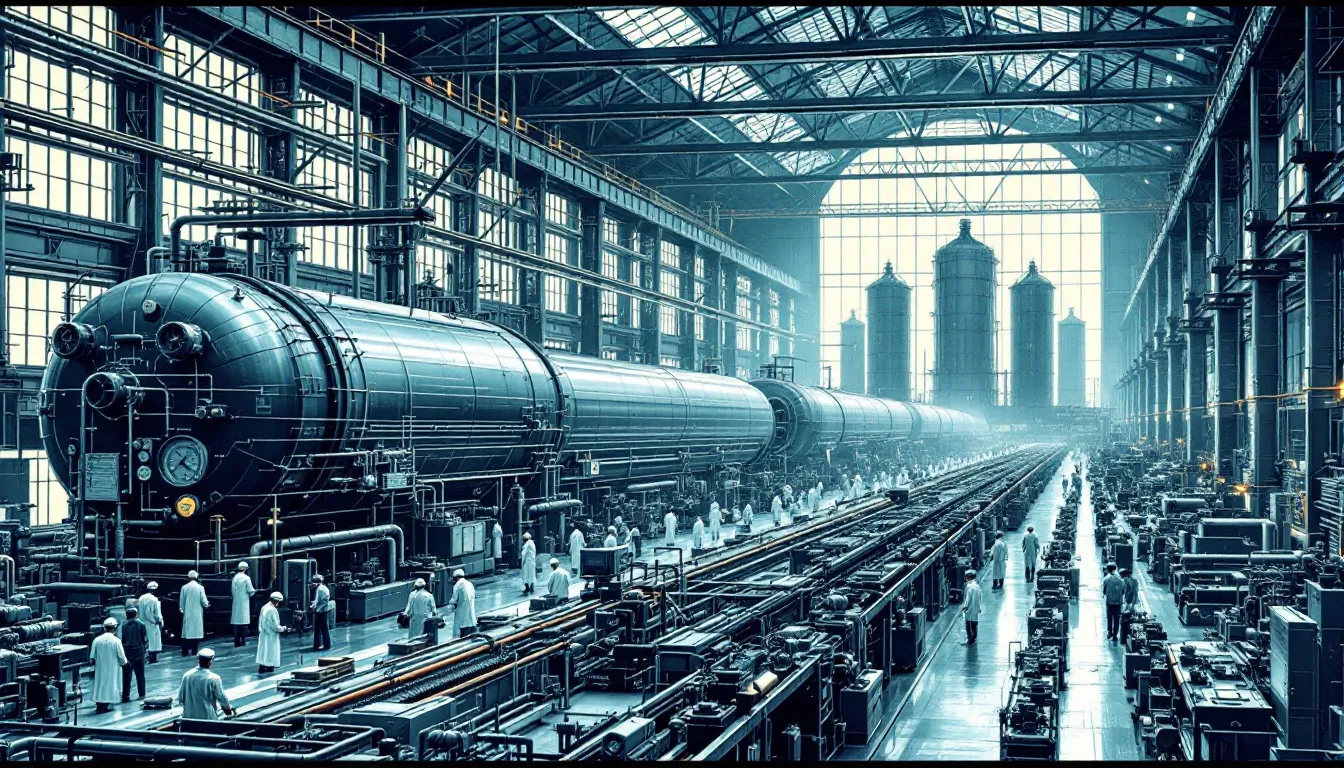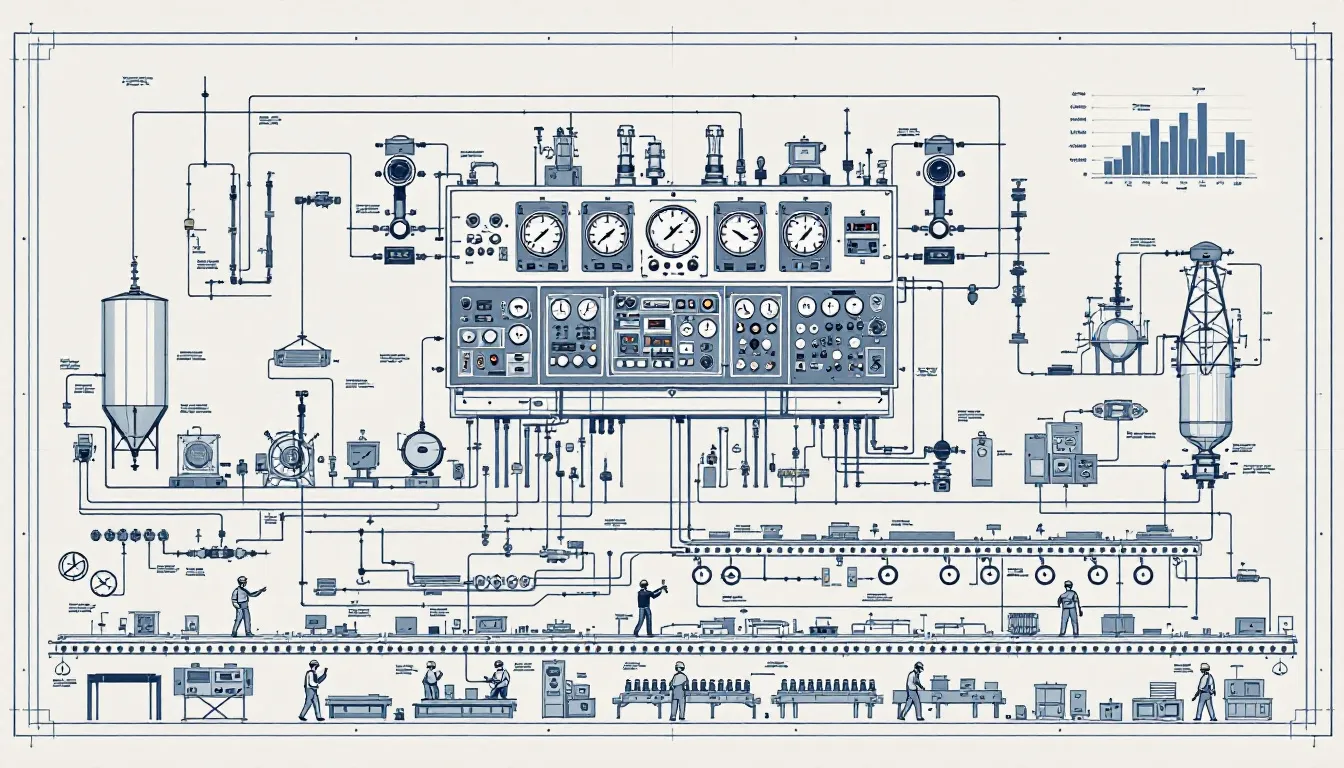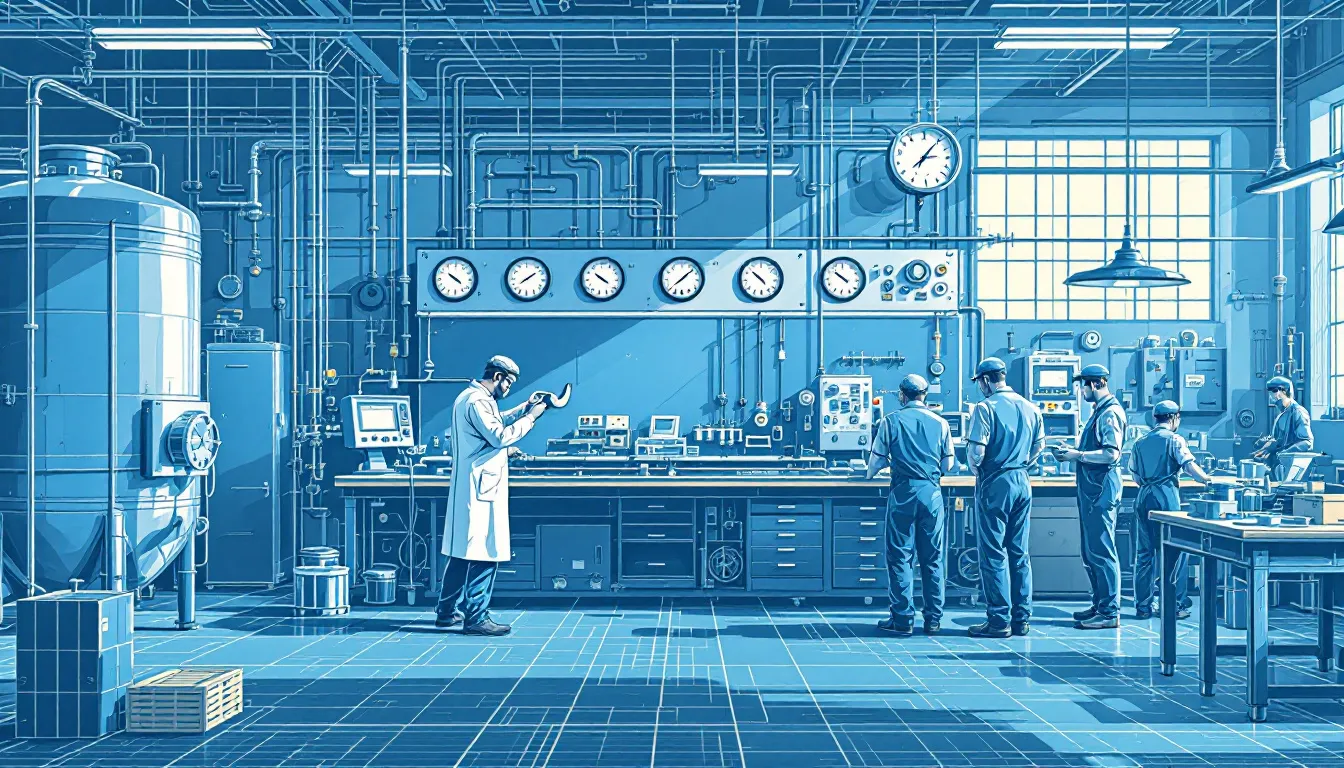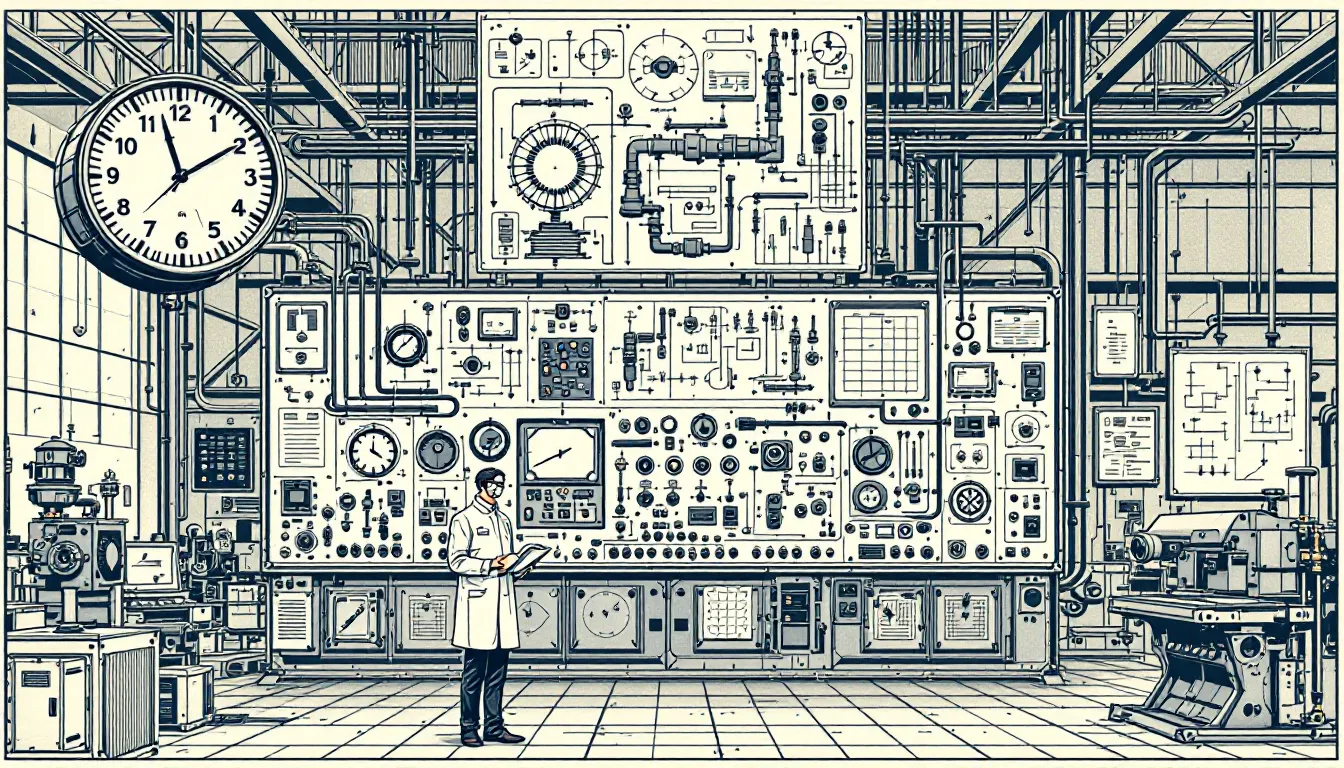Manufacturing process monitoring involves continuous inspection and real-time data collection to enhance production efficiency and quality. It’s crucial for minimizing downtime, optimizing resource usage, and supporting data-driven decision-making.
In this article, we’ll explore the key aspects and benefits of manufacturing process monitoring.
Key Takeaways
-
Manufacturing process monitoring enhances operational efficiency by providing real-time insights that facilitate data-driven decision-making and continuous improvement.
-
Key components of effective production monitoring systems include advanced software for data curation, seamless integration with existing systems, and a focus on real-time data collection and analysis.
-
Investing in predictive maintenance through monitoring systems can significantly reduce downtime and maintenance costs while extending the lifespan of machinery.
Understanding Manufacturing Process Monitoring

Manufacturing process monitoring refers to the continuous on-site inspection, real-time data collection, and monitoring processes that are integral to modern manufacturing operations. The primary goal of production monitoring is to improve operations through accurate data collection, thereby enhancing efficiency, reducing downtime, and enabling data-driven decision-making.
Comprehending the manufacturing process enables businesses to swiftly adapt to market changes, optimizing their operations and supporting continuous process improvement in manufacturing industries. Understanding the intricacies of manufacturing processes and industrial processes allows companies to minimize resource usage, adopt sustainable practices, and enhance operational efficiency, including the efficient use of raw material in the production process. Manufacturers require a comprehensive solution to track a range of different metrics in order to measure, analyze, and provide a clear overview of the entire manufacturing process.
Production monitoring systems provide real-time insights into production processes, which is crucial for modern manufacturing facilities aiming to maximize productivity and operational efficiency. Advanced manufacturing monitoring systems improve processes by providing actionable insights that enhance operational efficiency and product quality.
Machine monitoring utilizes collected data to continuously improve machine operation, contributing to overall efficiency. With production monitoring software, manufacturers can analyze production data and make informed decisions that drive continuous improvement.
Key Components of Effective Manufacturing Process Monitoring Systems

An effective production monitoring system relies on several key components, starting with the production monitoring software that simplifies data curation and analysis, providing advanced reporting tools. Continuous collection and analysis of data from machines, sensors, and production lines are essential activities in production monitoring. Advanced manufacturing platforms can automate data collection at every step of the production process, ensuring accuracy and efficiency. These systems typically integrate with PLCs and ERP systems to streamline operations and ensure seamless data exchange.
OEE systems, covering aspects such as real-time data collection, performance analysis, visualization, and control, are crucial for effective monitoring. However, challenges in software integration, such as compatibility issues between different systems and other systems, can disrupt automation processes. To overcome these challenges, data standardization across manufacturing systems is crucial for effective integration, allowing for consistent data exchange. Short Interval Control (SIC) can enhance operational efficiency by reviewing production data regularly to identify issues and implement timely solutions.
Adopting a unified namespace strategy improves data quality and integrity by creating a central repository for consistent data formats. Advanced production monitoring systems require integration capabilities, real-time insights, and analytical capabilities. Essential features to consider in production monitoring systems include compatibility, data accuracy, user-friendliness, and integration capabilities.
Effective production monitoring software can acquire data from machines, clean it, and present it through tailored dashboards, making it an essential tool for production managers. Customizable dashboards enable manufacturers to visualize relevant production data quickly and efficiently, allowing for better decision-making and operational improvements.
Real Time Data Collection and Analysis
Effective monitoring systems utilize real-time data collection through sensors and IoT-enabled machines, ensuring that production data is continuously updated and accurate. Real-time data collection helps in identifying operational bottlenecks and predicting maintenance needs, allowing for timely interventions that reduce idle time and improve workflow. Additionally, real-time data from production monitoring can alert personnel to quality issues, enabling swift corrective actions to maintain product standards. These systems are designed to collect data efficiently, enhancing overall operational effectiveness.
Data analysis in monitoring systems helps identify patterns and anomalies for improved efficiency. The use of AI and machine learning in real-time monitoring can identify patterns that uncover opportunities to gain insights for efficiency, leading to significant productivity gains. Access to real-time data enables quick adjustments, enhancing product quality and reducing defects, allowing teams to visualize data effectively.
Manufacturers using real-time monitoring have seen production efficiency increase by up to 20%, demonstrating the substantial benefits of these systems. Real-time monitoring also contributes to a proactive maintenance culture, significantly cutting down maintenance costs and helping to reduce downtime. Adopting predictive maintenance can lead to a reduction in equipment breakdowns by as much as 70%, further enhancing overall production performance.
Enhancing Production Efficiency Through Monitoring

Integrating monitoring systems with existing production setups facilitates a comprehensive view of operations, improving decision-making and operational efficiency. Seamless communication between systems like ERP and automation tools can boost productivity by 6% to 30%. Real-time data provided by monitoring systems allows for immediate corrective actions, leading to enhanced production efficiency and reduced costs.
Continuous tracking of production metrics allows for immediate insights and faster decision-making in manufacturing. Automating data collection from machinery significantly enhances production efficiency and reduces manual data entry errors, ensuring accuracy and reliability. The implementation of production monitoring systems can significantly enhance machine utilization, with increases of up to 6% or more reported in automated assembly.
Leveraging advanced production monitoring software enables manufacturers to analyze production data, identify improvement opportunities, and implement changes that drive continuous improvement and operational excellence. Integrating real-time production monitoring into operations ensures efficiency, reduces waste, and improves safety on the plant floor.
Quality Monitoring and Control in Manufacturing Processes

Investing in understanding manufacturing processes helps in identifying potential defects and implementing effective quality control measures. Effective quality control directly influences customer satisfaction and brand reputation in manufacturing. Implementing robust quality control methods allows manufacturers to produce safer products and improve safety, particularly in high-risk industries. With effective production monitoring, manufacturers can enhance employee safety by alerting staff to potential machine hazards, reducing the risk of workplace accidents.
Regular audits of quality control processes help identify improvement areas and maintain high standards. Proactive quality control from real-time monitoring helps identify trends and defects quickly, leading to improved product standards and reduced cycle times. Continuous data collection through monitoring systems and supervisory control helps in maintaining high quality data and consistency in product output, ensuring that every product meets the required standards.
Investing in adaptable machinery and smart systems, including programmable logic controllers and production equipment, is crucial for maintaining quality during production scaling. User-friendly interfaces are essential for enabling stakeholders to easily access and utilize monitoring insights, thereby enhancing overall production performance. Manufacturers are increasingly investing in robust manufacturing platforms to automate data collection, ensuring efficiency and accuracy across production processes.
Predictive Maintenance and Reduced Downtime
Predictive maintenance can extend the lifespan of machinery by minimizing wear and tear through regular, data-driven preventive maintenance. Implementing AI-driven predictive maintenance can result in significant maintenance cost savings, often around 25%. Real-time monitoring allows manufacturers to respond promptly to production issues, thereby minimizing downtime and inefficiencies.
AI enhances predictive maintenance by analyzing data from multiple sources to detect patterns indicating potential equipment failures. Integrating AI-powered predictive maintenance systems can be complex, often requiring a flexible infrastructure for seamless data flow. Despite these challenges, the benefits of predictive maintenance, such as reduced downtime and improved equipment efficiency, make it a worthwhile investment for AI in manufacturing companies.
AI models in predictive maintenance continuously improve their predictive accuracy by learning from new data over time, ensuring that maintenance efforts are always optimized. This proactive approach to maintenance not only reduces costs but also ensures machine availability and operational efficiency.
Integrating Monitoring Systems with Other Manufacturing Operations
A successful production monitoring system integrates with ERP, MES, and SCM for cohesive data management, ensuring that all aspects of the manufacturing process are aligned and optimized. Integrating real-time monitoring with systems like ERP fosters better coordination across manufacturing departments, leading to improved overall equipment efficiency.
However, challenges in implementing real-time monitoring include high initial costs and integration issues with legacy systems. Addressing integration issues is crucial for maximizing the benefits of monitoring systems in manufacturing operations. By ensuring seamless integration, manufacturers can achieve a unified view of their operations, allowing for better decision-making and improved production performance.
Integrating different sensors and integrated systems allows businesses to collect comprehensive production monitoring data, enhancing their ability to monitor processes and ensure product quality. This integrated approach enables manufacturing companies to streamline their operations, reduce waste, and enhance machine utilization.
Customization and Scalability of Monitoring Systems
Flexibility and scalability of monitoring systems are crucial for adapting to evolving production needs, ensuring that the system can grow with the business. Scalability and flexibility are important considerations for a production monitoring system in growing businesses, as they allow for easy addition of new production lines or sensors without extensive downtime.
Effective scaling in manufacturing requires:
-
Flexible manufacturing equipment that can adapt to various product configurations
-
Modular production lines that allow for incremental capacity increases, minimizing disruption during expansion
-
Data-driven planning and advanced automation that are essential for creating manufacturing operations that can scale effectively
This ensures that production systems are ensuring efficiency and responsive to market demands.
Investing in customizable and scalable monitoring systems ensures that operations remain efficient and adaptable as production needs change. This approach not only enhances operational efficiency but also supports continuous improvement and long-term growth.
Evaluating the ROI of Manufacturing Process Monitoring Systems
Key factors in assessing the ROI of production monitoring systems include cost savings, productivity gains, and improved product quality. Investing in a production monitoring system often results in substantial cost savings by reducing wasted time, labor, and energy. Advanced scheduling features in monitoring systems can save up to 50% in planning resources compared to traditional methods. Industry 4.0 technologies provide tools to enhance production efficiency and maintain competitive advantage, making them a valuable addition to modern manufacturing operations.
Accurate reporting and analytics from monitoring systems enable manufacturers to identify and act on performance discrepancies, leading to improved operational efficiency. For example, Tacony achieved a 9x ROI after implementing the Mingo Smart Factory, showcasing the potential financial benefits of monitoring systems. Moreover, Tacony also achieved a 150% reduction in lead time, illustrating effective performance improvements post-implementation.
Assessing the return on investment (ROI) for manufacturing process monitoring systems is crucial for understanding their value in enhancing operational efficiency. Evaluating these factors allows manufacturers to make informed decisions about implementing and optimizing their monitoring systems.
Implementing a Manufacturing Process Monitoring System: Step-by-Step Guide

Implementing a production monitoring system involves six key stages:
-
Identifying challenges
-
Assessing machinery
-
Determining necessary data
-
Data collection methods
-
Addressing identified issues
-
Analyzing production data and applying the insights gained to process data
Businesses should consider core features, evaluate options, and ensure alignment with specific needs and goals when selecting a production monitoring system to identify areas.
Careful implementation and employee training are crucial after implementing a production monitoring system. Following a structured approach ensures a smooth transition and maximizes the benefits of the monitoring system for manufacturing companies.
By addressing these key stages, manufacturers can successfully implement a robust monitoring system that enhances operational efficiency, reduces downtime, and improves product quality. This structured approach ensures that the monitoring system is tailored to the specific needs of the manufacturing facility, leading to long-term success.
Summary
Manufacturing process monitoring is essential for modern manufacturing operations, offering numerous benefits such as improved operational efficiency, reduced downtime, and enhanced product quality. By understanding the key components of effective monitoring systems, leveraging real-time data collection and analysis, and integrating these systems with other manufacturing operations, manufacturers can achieve significant productivity gains and cost savings.
Implementing a robust monitoring system requires careful planning, employee training, and continuous improvement. By following the best practices outlined in this guide, manufacturing companies can optimize their operations, ensure product quality, and achieve long-term success. The journey to operational excellence begins with embracing the power of manufacturing process monitoring.
Frequently Asked Questions
What is manufacturing process monitoring?
Manufacturing process monitoring entails the ongoing inspection and real-time data collection that are crucial for optimizing manufacturing operations. This approach enables timely adjustments and enhances overall efficiency.
How does real-time data collection improve production efficiency?
Real-time data collection significantly enhances production efficiency by identifying bottlenecks and predicting maintenance needs. This allows for timely interventions that minimize idle time and optimize workflow.
What are the key components of an effective production monitoring system?
An effective production monitoring system comprises production monitoring software, continuous data collection, and integration with PLCs and ERP systems, ensuring data accuracy and user-friendliness. These components collectively enhance operational efficiency and reliability.
How does predictive maintenance reduce downtime?
Predictive maintenance effectively reduces downtime by minimizing wear and tear through regular, data-driven maintenance, which helps prevent equipment breakdowns and extends the lifespan of machinery.
What factors should be considered when evaluating the ROI of a production monitoring system?
When evaluating the ROI of a production monitoring system, it is crucial to consider cost savings, productivity gains, and improvements in product quality, along with real-world examples that showcase significant financial benefits. These factors collectively help in determining the overall value of the system.
Share this
You May Also Like
These Related Stories

Top 7 IoT Use Cases in Manufacturing for 2025

Maximizing Efficiency with Predictive Analytics in Manufacturing


No Comments Yet
Let us know what you think